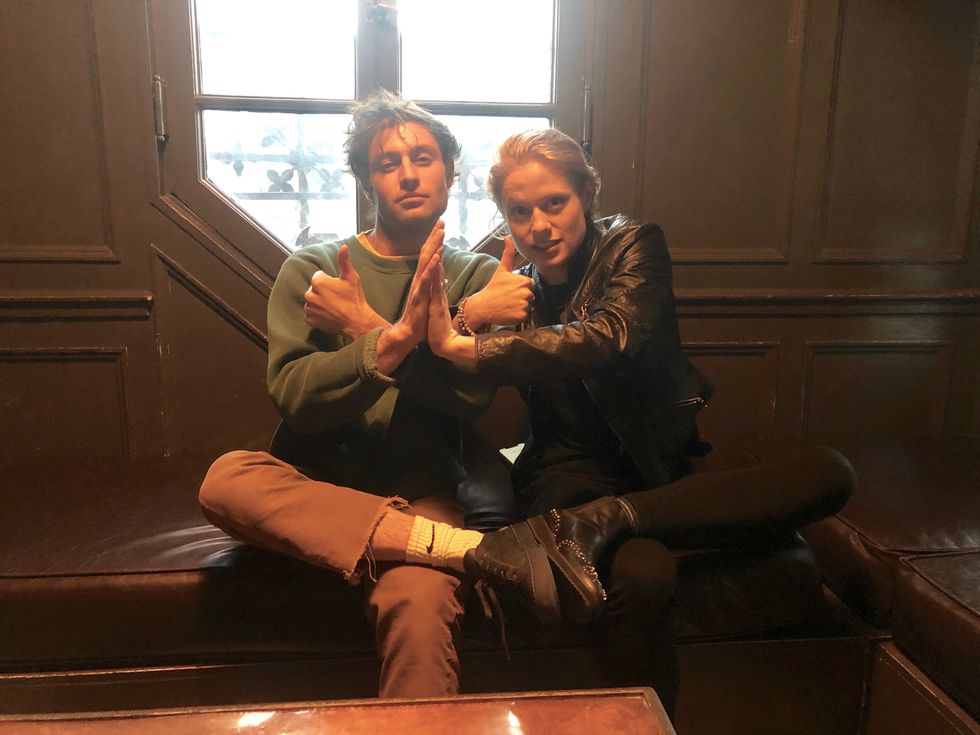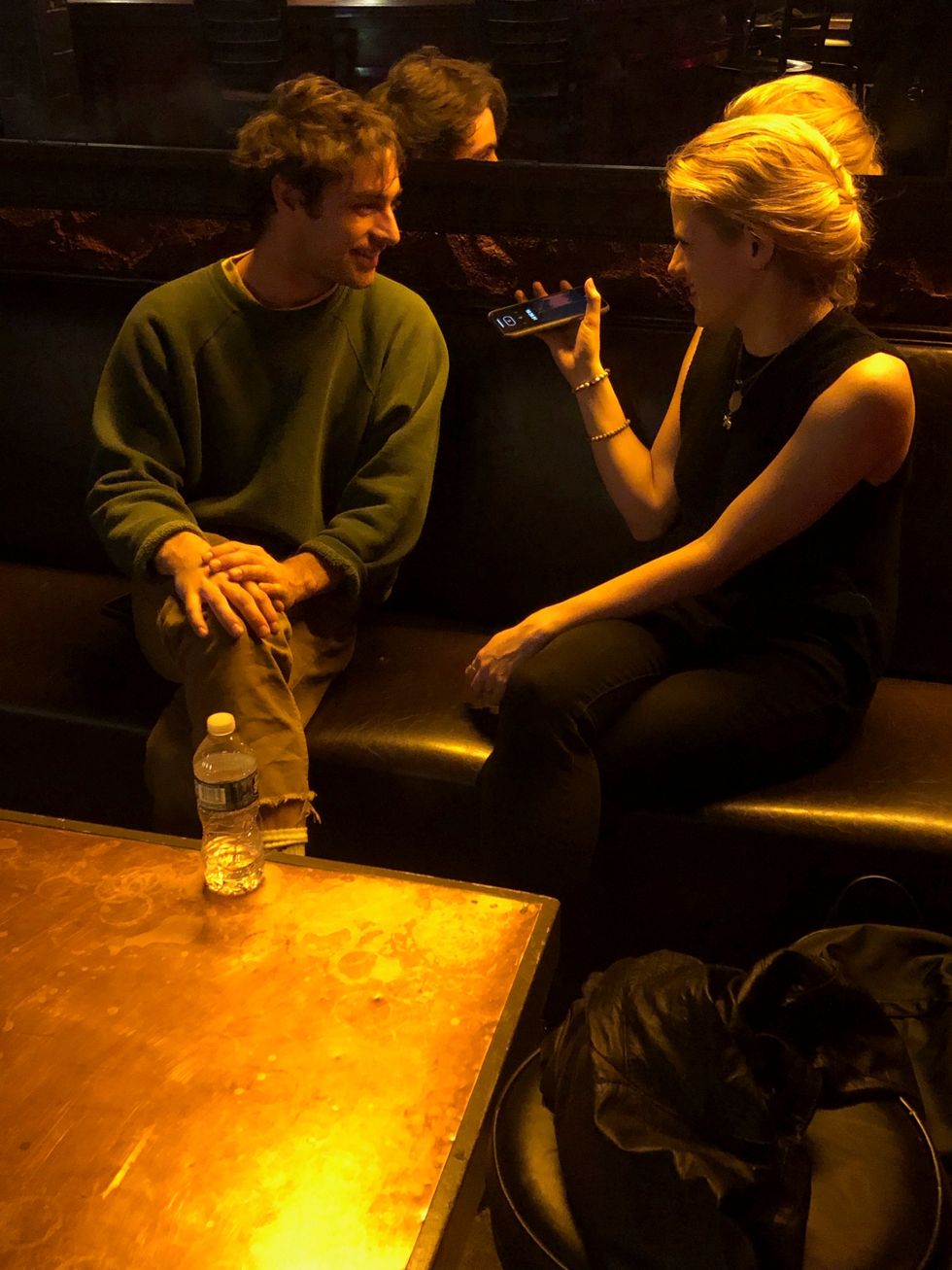
Before his sold out show at Bowery Ballroom, I sat down with Adrian Galvin — better known as Yoke Lore — for an interview that turned out to be a study in contrast.
Despite a soft voice and a less than imposing physical presence, there’s something about the singer that captures your full attention. He’s thoughtful and perceptive, but also frenetic: he switches easily between eloquent observations about Buddhist teachings and anecdotes about his favorite sneakers in which he uses phrases like “one hunnit.” If you combined a Venice beach skate bro and a gentle forest nymph, you’d probably get something close to Adrian Galvin.

This versatility is made clear in the unusual and varied trajectory of Galvin’s career. He was previously a member of Walk the Moon, before leaving the band to strike out on his own with a group called Yellerkin. But, ever-restless, Galvin soon left Yellerkin behind to create his third, and perhaps most successful, musical incarnation: Yoke Lore. A distinctive monniker, Galvin describes the meaning of the name in the same roundabout, exploratory way I soon learn he describes everything: “I’m very interested in real things. A yoke is something that brings up work and human praxis and a certain type of reality that I’m interested in exploring. A yoke holds things together. Lore is about what’s happening.”
To Galvin, “what’s happening” is just as broad a category as it seems. Perhaps recognizing this lack of specificity, he thinks for a moment before continuing, “It’s about, you know, the stories of how things happen, how things are bound together.” He searches my face, clearly wanting me to recognize the beauty of the name. He gently places a hand on the brick wall behind us. “I believe very much that the value of this wall isn’t in the value of the stones but in the value of the mortar. I want to explore the value of the things that hold things together.” I nod, causing him to smile brightly, pleased I see what he means.
Galvin is no stranger to these kind of spiritual inexactitudes, he mentions that there’s a lot of biblical imagery in his music because he grew up “steeped in religious education.” He explains that this is because of another contradiction that made him who he is: “My mother’s a devout jew and my father’s a pretty ardent catholic. So we did both. And there’s a lot of biblical imagery in my music because those are the words that I know.”
It’s not only the language that strikes a holy chord in the music of Yoke Lore; there’s also a reverence that runs through the heart of his sound. While the seeds of this are in his previous work, it’s clear that Galvin finally found the full breadth of his musical voice in this project. His music is distinct and atmospheric, with folk components layered under scintillating percussion and synths, creating a product as delightfully contradicting as Galvin himself. He says he never necessarily intended this sense of reverence, but said, “I want it to be meaningful, I want it to feel elevated. And I think that conversation around spirituality is such a built-in part of our culture.”
That sense of spirituality is as much a part of Galvin’s life as it is his music, when asked how he’s adjusting to his growing fame, he first says, “I’m comfortable with it, I’m ready for it. Its expected and welcome.” But, he adds, “I don’t want to be a megalomaniac ever, I want to stay small.” He hesitates for a moment, struggling to phrase his next sentence in a way that won’t come off as pretentious, “I studied a lot of religious…shit.” He smiles sheepishly, “The buddhists say something I really like about making yourself small, like making everything small in order to exercise your humanity more. There’s this guy called E.F. Schumaker who wrote a book called Small is Beautiful and it’s all about Buddhist economics and how you live in the loud and big modern world and play against it with your own life.” But then, clearly feeling qualms that this wasn’t an entirely honest representation of himself, he backtracks, saying abruptly, “I’m arrogant as fuck sometimes. But it’s the same thing as being small and quiet, it’s more of a device to balance my external environment so I can feel okay.”
He looks at me again, eager for me to understand, eager to be understood. He continues in a softer voice, introspective, “I also had this idea when I was little… well, I was always around these big loud men who didn’t have anything to say and I really didn’t want to be that dude ever. I’ve always wanted to be a little bit quieter, speak a little bit softer. When someone’s like super loud they can’t listen. I want to listen.”
“So you want to listen, but what is it you want to say?”
This question frustrates him slightly, the first time he’s anything but cheerful, his eyes seem to accuse me of not listening to the subtleties of his answers so far. “It’s not something I’m trying to say as much as it’s a feeling I’m trying to engender,” he firmly asserts, seeming to genuinely care that I see who he is as an artist. “I want to create this space for people to think more, to be reflective, to listen more, and I want the visual art to do that for the music. I want the art to set up a space in which people can hear things a little bit cleaner or feel things a little bit more personally.” His passion is infectious, and I nod enthusiastically. He relaxes again, smiling, and I ask about the visual art he mentioned.
He lights up, all but pulling out a portfolio to show me the drawings he’s referring to, excitedly sharing he’s going to have an art show in LA this May.
He explains the relationship between his music and his drawing as two different ways to say the same thing: “I guess it’s like when you’re shooting a movie you want to have like six angles for every shot, and the more perspectives you have the better picture of reality you can create. I wanna take an idea and present it in many mediums. So that you can really get it, or it can be a little bit more familiar.” For all his previous emphasis on the importance of listening, he’s suddenly harping on the very thing I’ve sensed from him all along: a desperate desire to be known and understood.
“And so that’s what this is all about for you? Being heard? Or is it about the fame or the money or the fans — one of those classic tropes?”
He gestures at the concert venue around him, “This? No, this is just a compulsion.” I laugh, shocked by the ease with which he asserts this despite the obvious intention and mindfulness he brings to everything else in his life. Straight faced and defiant, he continues, “it’s just like when you put Adrian on the ground, he sings. It’s just what happens. If you eat food you have to shit in a couple hours. You put life in my body, I’m gonna make music. So this is something I’ve done since forever. Since someone gave me an instrument.”
Later in the night, this is easy to believe as I watch him bewitch the packed house with his ethereal voice and absolute self-possession. He’s a magnetic stage presence, ceaselessly moving to the music as he croons, plays guitar, and interacts with the audience. His performance is precise, like worship, but also delightfully messy and human. Most of all, the concert feels like watching the most expansive, honest form of the fascinating person I met that afternoon. Purpose mixes with compulsion. Bravado mixes with a desire to remain small. Intense introspection mixes with a lack of self awareness. Spirituality mixes with the absence of belief. Adrian Galvin is all of these things and more, and the music he makes as Yoke Lore is as varied and colorful as he is.Check out his newest music video for “Beige (unburdened)” from his forthcoming acoustic EP, Meditations.
Yoke Lore – “Beige (unburdened)” (Official Music Video)youtu.be
For more from Yoke Lore, follow him on Twitter, Facebook, and Instagram.
Brooke Ivey Johnson is a Brooklyn based writer, playwright, and human woman. To read more of her work visit her blog or follow her twitter @BrookeIJohnson.
POP⚡DUST | Read More…
Down the Rabbit Hole: Exploring Weird YouTube
Fetishizing Autism: Representation in Hollywood
5 Romantic Movie Gestures That Are Actually Super Creepy
- Yoke Lore On Bedding Folk With Pop, and Getting Love From Taylor … ›
- Yoke Lore – Tickets – The High Watt – Nashville, TN – March 17th … ›
- Yoke Lore on Spotify ›
- Y O K E L O R E (@yoke_lore) | Twitter ›
- YOKE LORE (@yoke_lore) • Instagram photos and videos ›
- Yoke Lore – YouTube ›
- YOKE LORE’s stream on SoundCloud – Hear the world’s sounds ›
- YOKE LORE – Home | Facebook ›















